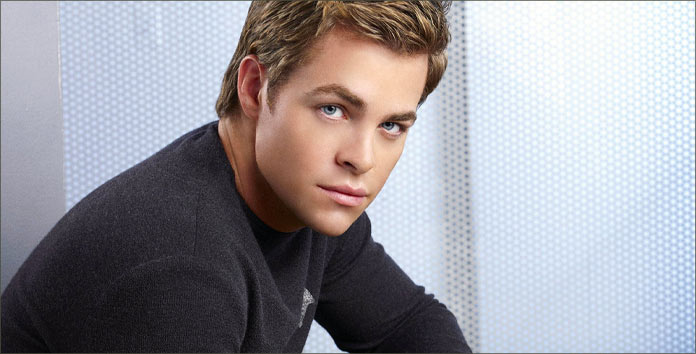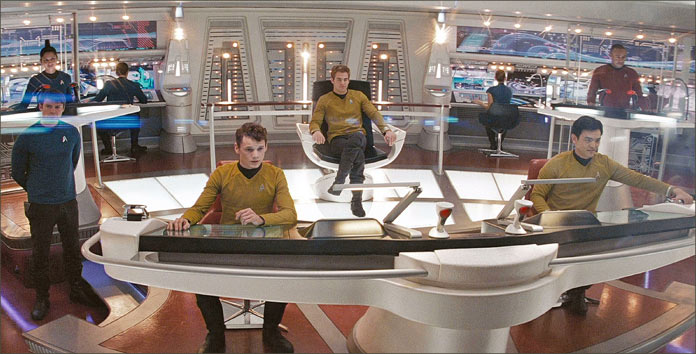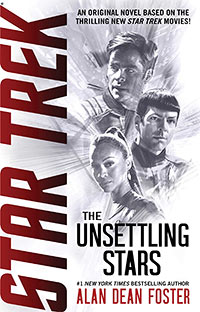A decade since it was announced, the first Star Trek novel set in the Kelvin Timeline finally beams onto novel readers’ bookshelves this month.
Alan Dean Foster’s The Unsettling Stars — previously announced under the titles Refugees and The Order of Peace — has finally been released ten years since it was pulled from planned publication.
At the time, it was rumored that Bad Robot requested the novels be canceled so as not to interfere with their burgeoning plans for what became Star Trek Into Darkness.
However, given we’re now four years since the latest movie in the Kelvin Timeline — 2016’s Star Trek Beyond — and the possibility that we’ve seen our last big screen adventure for Chris Pine’s Captain Kirk and crew, Simon & Schuster have revisited this novel and delivered it into the curious and waiting hands of readers, telling a tale based on the… um… “new” Star Trek movies.
The Unsettling Stars is an enjoyable episodic story that takes advantage of some of the unique elements of the Kelvin Timeline, while grounding the narrative in the characters and story elements that one would expect from Star Trek. Set in the days following the events of the 2009 film, this novel focuses on the young, inexperienced Captain James T. Kirk and crew — thrown together by the chaos of Nero’s invasion of the Federation and the destruction of Vulcan — and who must now do the hard work of becoming a cohesive crew.
The novel does not shy away from grappling directly with one of the 2009 film’s most controversial creative choices: elevating James T. Kirk from cadet to captain in the space of one movie. This is a Jim Kirk who knows he has a lot to prove, who understands that he does not have a long track record of success to lean upon, and who is all-too-keenly aware and that his captaincy could be taken away from him at any moment.

As a result, this is a Captain Kirk who is more under the microscope than his Prime Timeline counterpart, which does engender some differences in behavior. While there are moments that you could be picturing either Pine or Shatner’s Kirk in your mind, there are others that are pure Pine and connect directly back to what makes this somewhat different than just another Original Series novel.
I was not entirely sure going into this book whether my mind would drift towards the Prime Timeline counterparts when “hearing” the character’s voices, given the reader lacks the visual context of seeing Chris Pine or Zachary Quinto playing the characters rather than William Shatner or Leonard Nimoy,
And while there were some characters for whom that was the case — Doctor McCoy is an irascible curmudgeon in any timeline, and Karl Urban’s depiction of McCoy skews closest to the Prime Timeline character of any of Original Series crew — it was not universally true. The Unsettling Stars’ depiction of Scotty, for example, doubles down on Simon Pegg’s unique interpretation of the role. You won’t “hear” a lot of James Doohan in the dialogue.
Each of the Kelvin Timeline crew gets something to do in the book, though like the first film, it features more of Kirk, Spock, Uhura, and McCoy than any other character. The story also explores Spock and Uhura’s relationship, as well as teases a bit more about Spock’s reaction to the destruction of Vulcan, though not perhaps as much as you’d prefer a decade after seeing the story on screen.

The story ultimately plays it as safe as you’d expect from a book originally scheduled for release not long after the blockbuster success of the first Kelvin Timeline film; it is careful not to disturb any toys in the toy box for later movies.
Nevertheless, it’s an enjoyable book that fits very much into the mold of a classic Star Trek story. The Enterprise encounters a refugee ship for a previously un-encountered race, the Perenoreans, who are under attack from hostile aggressors. Kirk and crew intervene and extends humanitarian assistance to the refugees.
I won’t go into any more detail about the plot so as not to spoil a book that was just released, but the book’s themes are about the convergence of expectations and reality, and how the Enterprise crew must manage and interpret some vastly different cultures.
There is action, but it is not the driving force for the plot and it is brains not brawn that ultimately wins the day. There is also a twist ending, which is both fairly well established and then subverted numerous times throughout the novel. I was as unsure as the Enterprise crew, by the time the twist revealed itself, whether it was going to be what I expected or not, which is to Foster’s credit. It did not come out of nowhere, but it was not entirely predictable either.

Overall, if you were interested in exploring more adventures of the Kelvin Timeline crew, The Unsettling Stars delivers just the kind of story you’re probably looking for. I expect August’s More Beautiful than Death by David Mack will be much the same, as it was also from the original set of novels written — and subsequently canceled — way back in 2010.
What will be most interesting, however, is if these two books are successful enough to spur the publication of more Kelvin Timeline content. With little indication that the movies will be continuing in their current form, does that allow authors a bit more of a free reign to develop the story as they please? We’ll have to wait and see.

